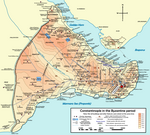Portal:Middle Ages/Selected article/18
The Walls of Constantinople are a series of defensive stone walls that have surrounded and protected the city of Constantinople (today Istanbul in Turkey) since its founding as the new capital of the Byzantine Empire by Constantine the Great. With numerous additions and modifications during their history, they were the last great fortification system of antiquity, and one of the most complex and elaborate systems ever built.
Initially built by Constantine the Great, the walls surrounded the new city on all sides, protecting it against attack from both sea and land. As the city grew, the famous double line of the Theodosian Walls was built in the 5th century. Although the other sections of the walls were less elaborate, when well manned, they were almost impregnable for any medieval besieger, saving the city, and the Byzantine Empire with it, during sieges from the Avars, Arabs, Rus', and Bulgars, among others (see Sieges of Constantinople). The advent of gunpowder siege cannons rendered the fortifications vulnerable, but cannon technology was not advanced enough to be decisive enough alone to capture the city, and the walls were repaired between reloading. Ultimately the city fell from sheer force of Ottoman forces on 29 May 1453 after a 6-week siege.
The walls were largely maintained intact during most of the Ottoman period, until sections began to be dismantled in the 19th century, as the city outgrew its medieval boundaries. Despite the subsequent lack of maintenance, many parts of the walls survived and are still standing today. A large-scale restoration program has been under way since the 1980s, which allows the visitor to appreciate their original appearance.

